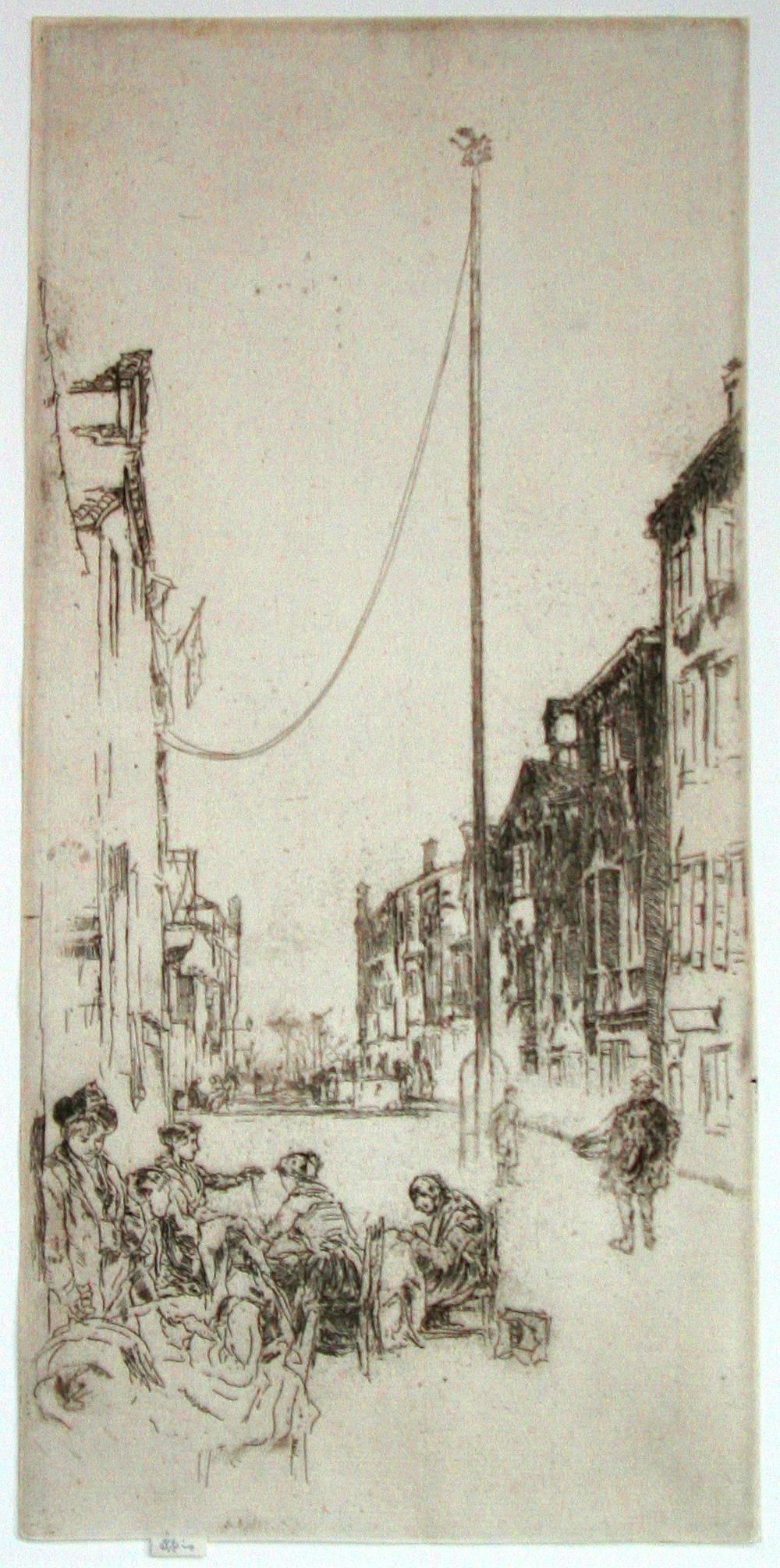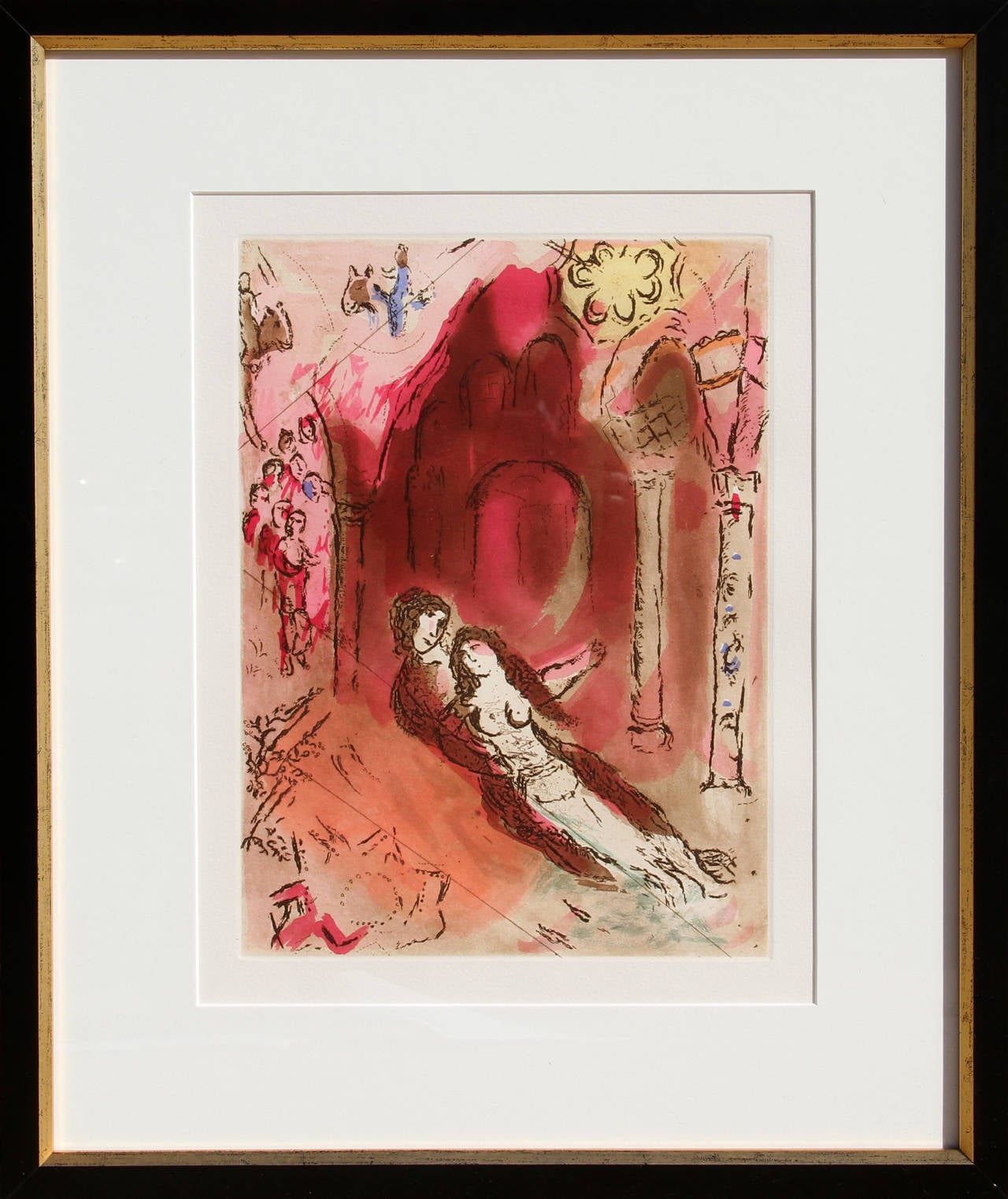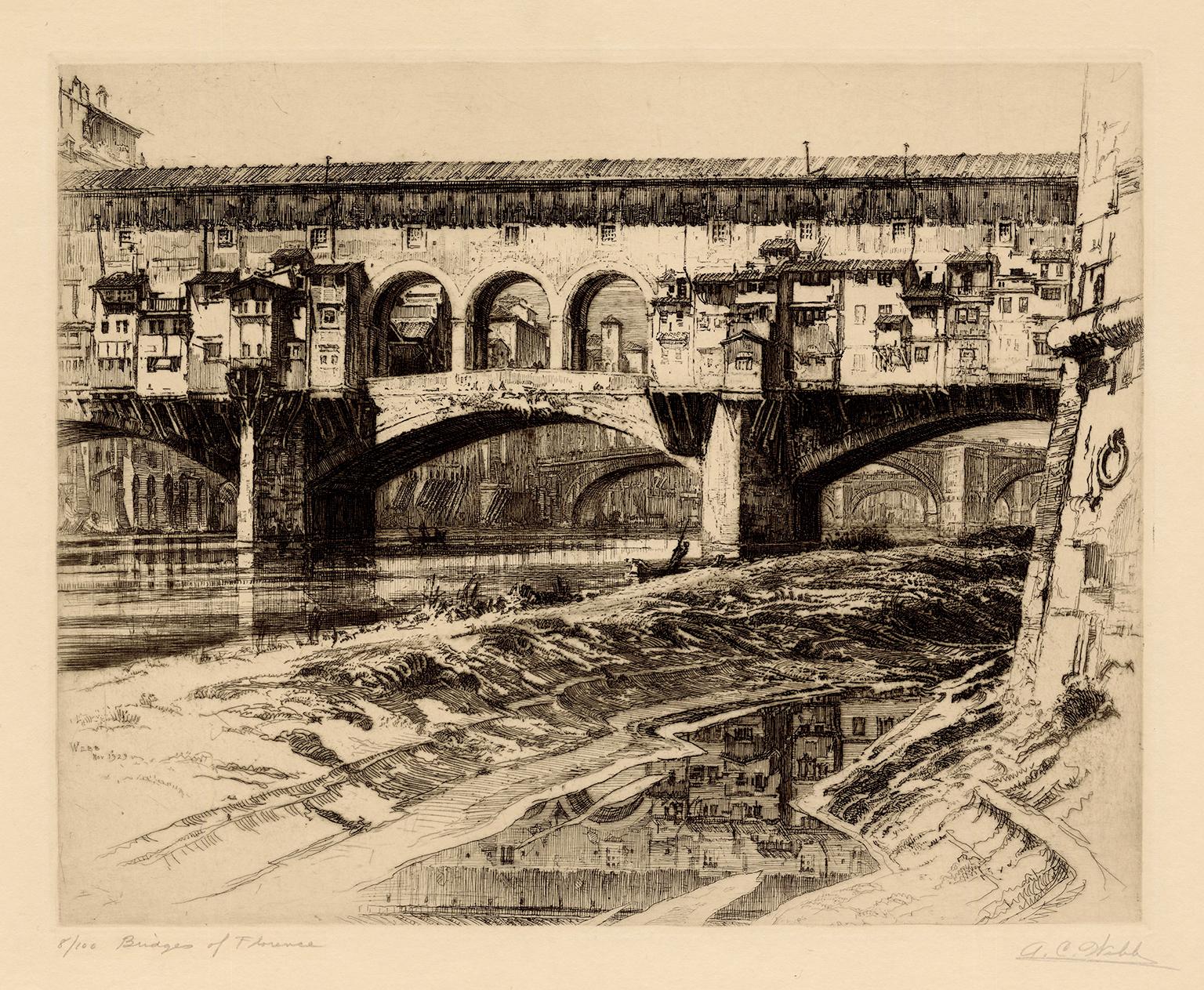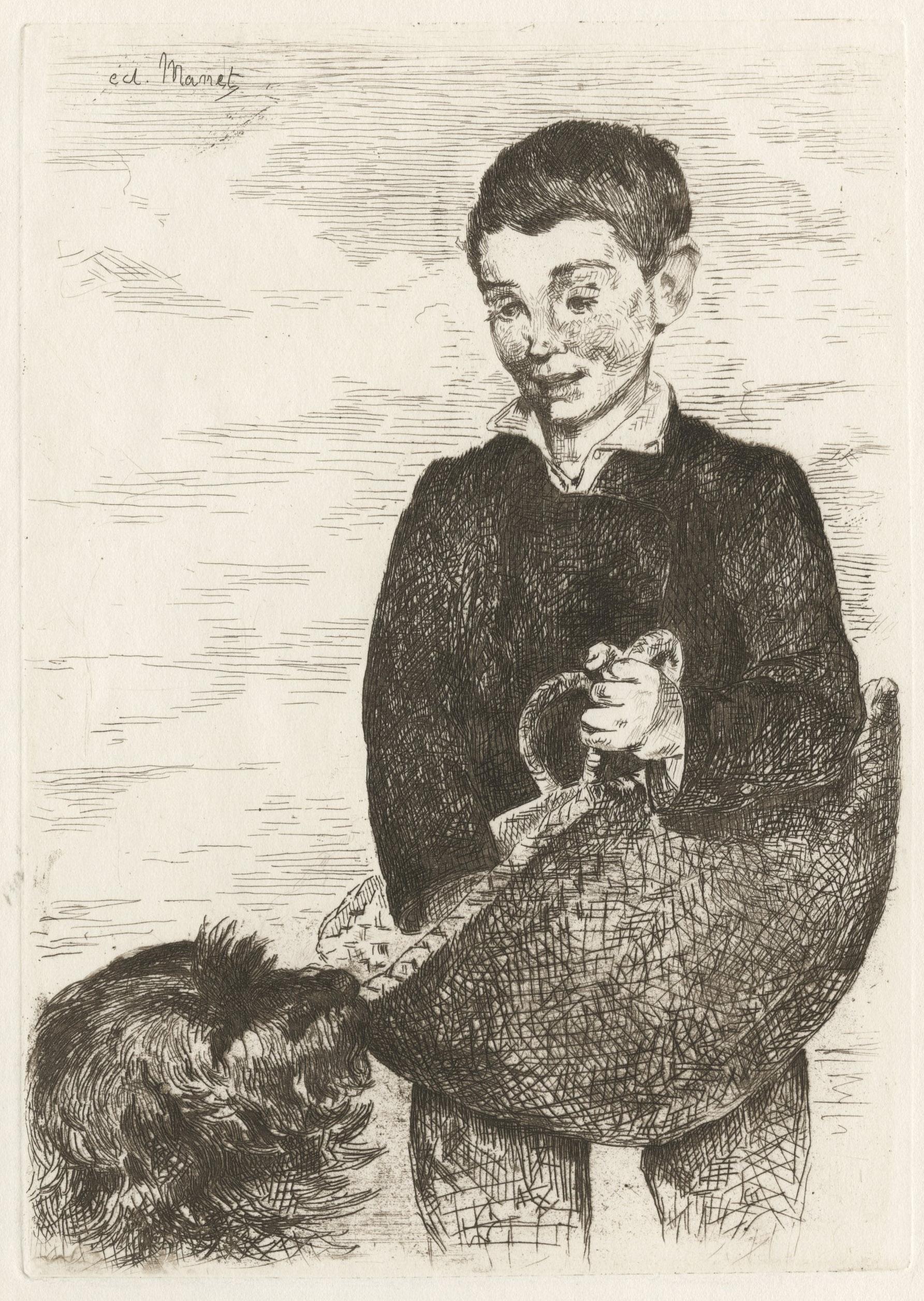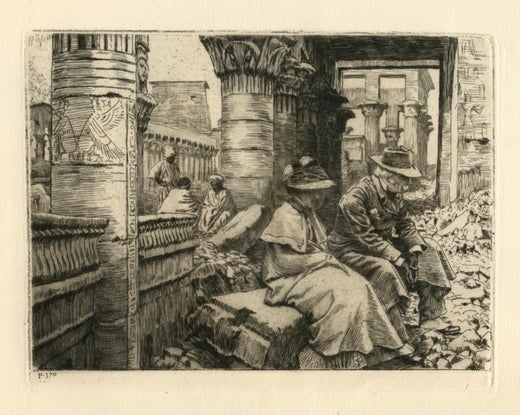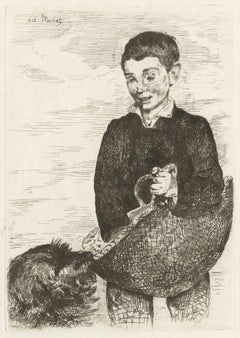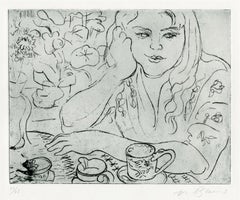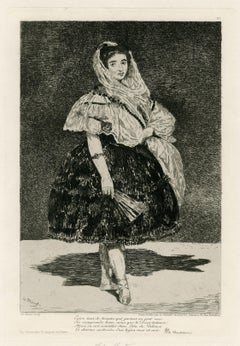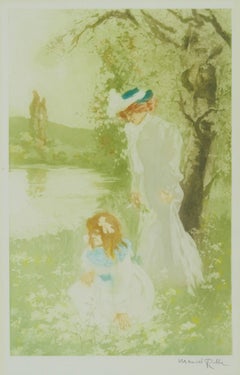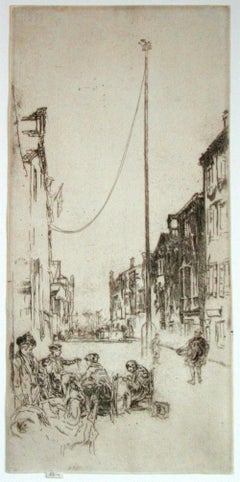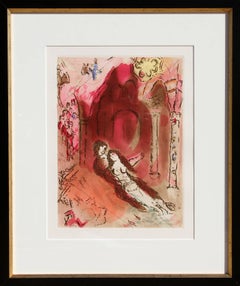Items Similar to Au bord de la mer (At the Sea Side)
Want more images or videos?
Request additional images or videos from the seller
1 of 7
James Jacques Joseph TissotAu bord de la mer (At the Sea Side)1880
1880
About the Item
Au bord de la mer (At the Sea Side)
Etching and drypoint, 1880
Signed in the plate middle left edge (see photo)
Edition: c. 100
A very rich impression, full of burr and contrasts
Printed on medium weight Dutch paper, with a partial Blauw watermark.
This usage of the Dutch paper is indicative of the first printing in London
Reference: Wentworth 47
Provenance: Sagot Heirs
Condition: Excellent
The sheet has appropriate aging for being 140 plus years old
Plate size: 14 7/8 x 5 3/8 inches
Sheet size: 16 1/8 x 6 3/8 inches
Frame: 30-3/4 x 19-3/8 x 1-3/4"
James Jacques Joseph Tissot
Jacques-Joseph Tissot was born in 1836, in Nantes in a seaport on the French coast. Throughout his life Tissot retained an affinity and fascination with all things nautical, and his marked ability to accurately paint rigging and shipboard scene paintings must have come from his boyhood. The son of a prosperous shopkeeper who was a devout Roman Catholic, the young Tissot was sent away to a boarding school run by Jesuits. Although initially unenthusiastic about the prospect of his son becoming an artist, Tissot senior eventually accepted the inevitability of his son's artistic pretensions.
In 1856 Tissot went to Paris to train as a painter. Here, at the Ecole des Beaux Arts the young Tissot met the young James McNiell Whistler (1834-1903), one of the most celebrated and unusual figures in 19th century art. At about this time Tissot also met, and became a friend of Degas (1834-1917) the Impressionist painter. Like Alma-Tadema, and Edward Burne-Jones, Tissot changed his name at this time to draw attention to himself. In his case he anglicized his Christian name to James. Tissot inherited the shrewd commercial instincts of his father, and like Alma-Tadema and Millais, was a painter-entrepreneur. In the 1860s he visited Italy, and in 1862 London. In 1864 Tissot exhibited his oil paintings at the Royal Academy for the first time, suggesting that he realized the potential of London as a source of wealthy patrons. He began to concentrate on contemporary scene paintings. In 1869 he produced caricatures for Vanity Fair magazine, including a brilliant caricature of the elegant, sophisticated Frederic Leighton at an evening reception.
Following the defeat of France and the occupation of Paris during the Franco-Prussian war, Tissot fled to England where he had a considerable number of contacts. He was initially the guest of the Editor of Vanity Fair, with whom he had become friendly, and who seems to have opened doors for him both socially and professionally. Tissot, hard working and shrewd, quickly became successful in London, where his oil paintings of social events and his conversation pieces rapidly became popular. These paintings look beautifully painted and were an interesting record of social life at the time, but were controversial. This was the time when commercially successful people were overtaking the landed aristocracy in wealth and as arts patrons. In some quarters Tissot’s paintings were regarded as depictions of the nouveau-riche. Ruskin was a particularly severe critic, describing them as "mere painted photographs of vulgar society." In 1873, Tissot bought the house in St John's Wood where he would live for the rest of his time in London, and started to become a significant figure socially. Tissot's success in London was regarded with envy by Degas and other painters of his circle in Paris.
In the mid 1870s Tissot met Kathleen Newton (1854-1882), an Irish divorcee with a distinctly colorful past. She had formed a sexual relationship with a man on a voyage to India to be married, and borne his child. Kathleen became Tissot’s model, muse, mistress, and the great love of his life. Many other successful men kept mistresses in St John's Wood, but they did not, like Tissot, live openly with them in adulterous relationships. This situation forced the painter to choose between his social life and Kathleen. To his credit he chose his lady. It would be wrong to think that Tissot became something of a hermit, as he and Kathleen Newton entertained their more bohemian artistic friends at home. But Tissot's days as a man-about-town were over, and he and Kathleen seem to have settled into a quiet life of domesticity. Kathleen's two children lived close by with her sister. Kathleen Newton was an extremely attractive young woman, and appeared in many of Tissot paintings at this time. In the late 1870s her health started to decline, with the onset of that great 19th century killer Tuberculosis. Tissot remained devoted to her. It is likely that the Roman Catholicism of both would not allow them to contemplate marriage. In 1882, the desperately ill Kathleen cheated consumption by committing suicide, and, as a result was not able to be buried in consecrated ground. With one week Tissot left his home at St Johns Wood, and never returned to it. The house was later bought by Alma-Tadema.
Tissot was devastated by his loss, and never really recovered from it. He seemed unable to accept the enormity and permanence of it. It is rumored that he considered marriage to other women later in life, but these affairs came to nothing. Like many English people at this time Tissot became interested in Spiritualism, and on a number of occasions tried to contact the dead Kathleen. The exotic French artist and his fallen women-one of the great 19th century English love stories. Initially Tissot carried on working back in Paris, in much the same manner as in London. Tissot produced a series of paintings of attractive, beautifully dressed women in sumptuous surroundings. These paintings were, for a time, extremely fashionable. Following this Tissot experienced a profound religious experience, and became increasingly devout. Tissot embarked on a series of religious paintings, visiting the Middle East on a number of occasions, to observe and paint backgrounds for his oil paintings. These paintings were well-received at the time, but in our more secular age have little appeal. James Tissot died on Friday 8th August 1902. Courtesy: James Tissot web site
- Creator:James Jacques Joseph Tissot (1836-1902, French)
- Creation Year:1880
- Dimensions:Height: 16.13 in (40.98 cm)Width: 6.38 in (16.21 cm)
- Medium:
- Movement & Style:
- Period:
- Condition:
- Gallery Location:Fairlawn, OH
- Reference Number:Seller: FA45701stDibs: LU14015623232
James Jacques Joseph Tissot
Jacques Joseph Tissot (French: [tiso]; 15 October 1836 – 8 August 1902), Anglicized as James Tissot (), was a French painter and illustrator. He was a successful painter of Paris society before moving to London in 1871. He became famous as a genre painter of fashionably dressed women shown in various scenes of everyday life. He also painted scenes and figures from the Bible.
About the Seller
5.0
Recognized Seller
These prestigious sellers are industry leaders and represent the highest echelon for item quality and design.
Platinum Seller
Premium sellers with a 4.7+ rating and 24-hour response times
Established in 1978
1stDibs seller since 2013
784 sales on 1stDibs
Typical response time: 1 hour
Associations
International Fine Print Dealers Association
- ShippingRetrieving quote...Shipping from: Fairlawn, OH
- Return Policy
Authenticity Guarantee
In the unlikely event there’s an issue with an item’s authenticity, contact us within 1 year for a full refund. DetailsMoney-Back Guarantee
If your item is not as described, is damaged in transit, or does not arrive, contact us within 7 days for a full refund. Details24-Hour Cancellation
You have a 24-hour grace period in which to reconsider your purchase, with no questions asked.Vetted Professional Sellers
Our world-class sellers must adhere to strict standards for service and quality, maintaining the integrity of our listings.Price-Match Guarantee
If you find that a seller listed the same item for a lower price elsewhere, we’ll match it.Trusted Global Delivery
Our best-in-class carrier network provides specialized shipping options worldwide, including custom delivery.More From This Seller
View AllLe Gamin (The Kid)
By Édouard Manet
Located in Fairlawn, OH
Le Gamin (The Kid)
Etching on laid paper, 1862
Signed in the plate upper left (see photo)
As published in Theodore Duret, L'Histoire d'Edouard Manet et de Son Ouvre, 1902 (The first ...
Category
1860s Impressionist Figurative Prints
Materials
Etching
Daureen, II
By Nell Blaine
Located in Fairlawn, OH
Daureen, II
Etching, 1969
Signed in pencil lower right
Edition: 28 (17/28)
Condition: Excellent
Two hinges from previous matting
Blaine studied etching at Atelier 17 in New York and considered one of their distinguished alums.
"Blaine was foremost an abstract painter, first a student of Theresa Pollak...
Category
1960s Impressionist Figurative Prints
Materials
Etching
Lola De Valence
By Édouard Manet
Located in Fairlawn, OH
Lola De Valence
Etching, 1862
Signed in the plate lower left: “Ed Manet”
Printed on chine collee paper, without watermark
From the first edition, published by Cadart and Luquet, Paris, before the removal of the inscription “ Ed. Manet sculpt”
From the 1863 edition, before the 1874 Portfolio, 1890 Portolio. 1894 Dumont edition and the Strolin edition of 100 in 1905
Pencil inscription with title below the plate in the lower margin
Conditiono: Excellent
Image size: 10 7/8 x 6 7/8 inches
Plate size: 18 3/4 x 13 inches
Reference: Harris-Manet 33 iii/III
Guerin-Manet 23 vi/VIII
The painting that this etching is inspired by is in the collection of the Musee d'Orsay, Paris.
"Lola de Valence is a painting by the painter Édouard Manet in 1862 . The canvas represents a dancer dressed intraditional Spanish clothes...
Category
1860s Impressionist Figurative Prints
Materials
Etching
Avril
By Manuel Robbe
Located in Fairlawn, OH
Avril (April)
Color aquatint and etching, c. 1906
Signed in pencil lower right
Edition: c. 100
Excellent impression, fresh colors
Reference: Merrill Chase Volume 1, No. 9
Condition: ...
Category
Early 1900s Impressionist Figurative Prints
Materials
Aquatint
La Terrasse de la Villa Brancas, Sevres (The Terrace of the Villa Brancas)
By Félix Bracquemond
Located in Fairlawn, OH
La Terrasse de la Villa Brancas, Sevres (The Terrace of the Villa Brancas)
etching & drypoint, 1876
Signed in the plate bottom right corner (see photo)
in plate, at lower left: xbre ...
Category
1870s Impressionist Figurative Prints
Materials
Etching
Noon Time Lull (Charleston, South Carolina)
By Louis Oscar Griffith
Located in Fairlawn, OH
Noon Time Lull (Charleston, South Carolina)
Etching, c. 1930
Signed by the artist in pencil lower right (see photo)
Note: An image done in South Carolina.
An impression of this image...
Category
1930s American Impressionist Figurative Prints
Materials
Etching
You May Also Like
Barcarolle.
By James McBey
Located in Storrs, CT
Barcarolle. 1926. Etching. Carter 233. 14 7/8 x 8 3/8 (sheet 17 1/4 x 10 1/4). Edition 80, #xxv. Print Collector's Quarterly 24 (1938): 428; Eric Denker, Reflections & Undercurrents: Ernest Roth...
Category
1920s Impressionist Landscape Prints
Materials
Drypoint, Etching
$9,000 Sale Price
33% Off
The Little Wheelwright's
By James Abbott McNeill Whistler
Located in Storrs, CT
The Little Wheelwright's. 1886. Etching. Kennedy 245; Glasgow 242. 2 1/2 x 3 3/4 (sheet 5 1/8 x 6 1/8). There was no lifetime edition. Glasgow lists only 13 other known impressions. A fine impression printed in black ink on white laid paper. Monogrammed with the butterfly in the plate. Housed in a 10 X 11 1/2 X 1-inch gold leaf period carved Celtic...
Category
Mid-19th Century American Impressionist Figurative Prints
Materials
Etching
The Venetian Mast
By James Abbott McNeill Whistler
Located in Storrs, CT
The Venetian Mast. 1879-80. Etching and drypoint. Kennedy catalog 195 state .vi; Glasgow catalog 219 state x/xii. 13 3/8 x 6 3/8. Glasgow records 53 impressions. A fine, atmospheric...
Category
1870s American Impressionist Landscape Prints
Materials
Drypoint, Etching
Granada, Modern Framed Etching after Marc Chagall
By (after) Marc Chagall
Located in Long Island City, NY
Artist: Marc Chagall, After, Russian (1887 - 1985)
Title: Granada
Year: 1962
Medium: Etching with Aquatint (Restrike)
Image Size: 13 x 9 inches
Size: 19 in. x 15 in. (48.26 cm x 38.1...
Category
1960s Impressionist Figurative Prints
Materials
Etching
$760 Sale Price
20% Off
'Bridges of Florence' — Firenze Impressionism
Located in Myrtle Beach, SC
Alonzo C. Webb, 'Bridges of Florence', etching, 1929, edition 100. Signed and titled in pencil. Signed and dated in the plate, lower left. A superb, richly-inked impression, in warm ...
Category
1920s American Impressionist Figurative Prints
Materials
Etching
Chemin de Halage
Located in San Francisco, CA
This artwork titled "Chemin de Halage" c.1930 is a color etching with aquatint on Wove paper by French artist Ferdinand Jean Luigini, 1870-1943. It is hand signed and titled in penci...
Category
Early 20th Century Impressionist Figurative Prints
Materials
Etching, Aquatint

